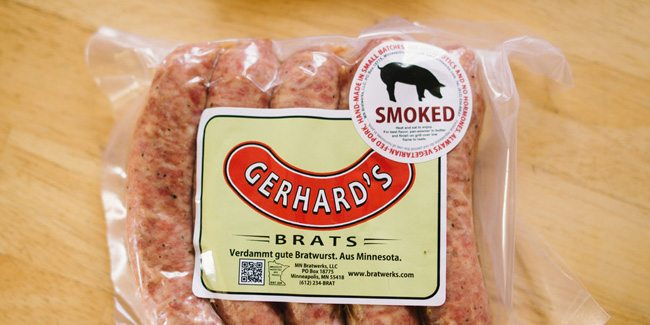
Good pizza is booming in the Upper Midwest; so is good coffee, good bread, and good cheese. Tastes are changing, driven from the ground up (small, artisan producers) and the top down (big companies and restaurants getting with — or at least claiming to get with — the farm-to-table trends).
Parallel to those developments is the rise (and revival) of artisan meat. You can see it in old meat shops coming back into vogue, in the explosion of house charcuterie programs at restaurants, and in the rise of new brands like Gerhard’s, a local bratwurst company dedicated to slowing down the art of making sausages.
We spoke to Gerhard’s co-founder Robert Lee (husband of France 44 cheesemonger Song Lee) about the theory of his product, and he immediately talked about his partner Gerhard Riautschnig’s village roots in Austria.
“He was surrounded by hogs — ‘Here’s how we slaughter hogs, and here are the 200 things we make out of hogs: blood sausage, and snouts, and ears…'” says Lee. “So he’s always made his own sausage here. We’re in a German cuisine region, so he was always the guy with the brat stash. People would tell him: ‘You should make these commercially.'”

Gerhard’s scaled up from a home operation to the France 44 kitchen to its current incarnation, wherein the brats are produced by a St. Paul butcher using pork from a northern Iowa pork farming co-op. “They’re all committed to a code of no antibiotics, vegetarian feed only,” says Lee. He also emphasized the small batch processes used to make the company’s sausages as opposed to industrial processes used by some larger brands.
“If you make your brats too fast, the temperature from the speed of the process can affect the fats involved, and give the brats a gumminess,” says Lee. “Our brats have integrity. [Brats] can have this mealy, pulpy, gummy thing, not that different from a hot dog, and they tend to be really salty. The more you go in the direction of a factory-made thing, the more you have chemicals for long shelf life.”
The brats (both smoked and fresh) that we tried were excellent — firm with a distinct snap, without any of the toughness or gumminess of texture that is often the downfall of even decent homemade sausages. A subtle, pleasant supporting note of natural garlic enhanced their flavor still further.
“The secret sauce is the way we do the garlic,” says Lee. “The ingredient list is salt, pepper, garlic, and how we apply [the garlic] really does make a difference.”

(As a side note: We tried our brats along side a bottle of Summit’s Meridian Session Ale (32 IBU, 4.5% ABV) which we found to be a balanced, tactfully hoppy pale ale with a hint of sweetness and a deft, quiet finish that encourages further sipping. The sessionable-yet-interesting sweet spot can be elusive, but Summit nailed it with Meridian.)
At the moment, Gerhard’s makes three kinds of bratwurst — fresh, smoked, and cheese — and the company is planning to roll out lines of kraut (“he does fantastic kraut with pork and pork fat and apple cider vinegar”) and landjaeger. At the moment, the company’s products are available at Harvest Moon Natural Foods Co-op, Eastside Food Co-op, France 44 Cheese Shop, Seward Co-Op, Surdyk’s, The Wedge Co-op, Golden Fig, and Hampden Park Co-op; Kowalski’s is on the current wishlist.

I really liked Gerhart’s offerings at the most recent North Coast Nosh.